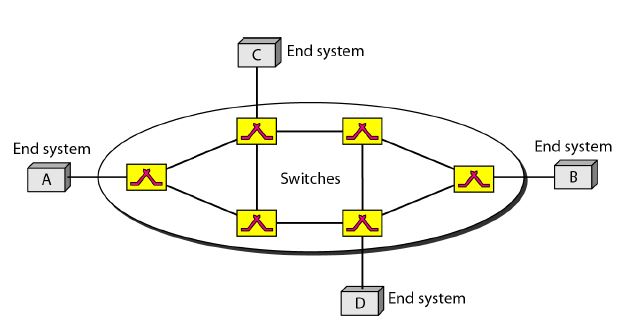A Virtual Circuit (VC) is a revolutionary concept in the field of telecommunications and network engineering, representing a shift from traditional physical connections to more dynamic, software-defined pathways. At its core, a Virtual Circuit is a logical path created between nodes in a network, allowing data to be transmitted as if there was a direct physical wire connecting them. However, unlike physical circuits, VCs are not bound by fixed wiring; instead, they are established through a series of network switches that direct data along various paths, depending on the network’s current configuration and traffic conditions.
Table of Contents:
- What is a Virtual Circuit?
- How Virtual Circuits Work
- Types of Virtual Circuits
- Virtual Circuits in WAN Technologies
- Advantages and Limitations of Virtual Circuits
- Virtual Circuits in Modern Networking
- References

1. What is a Virtual Circuit?
A Virtual Circuit is a logical path between nodes in a network, typically a telecommunications network. The path comprises discrete segments of the network that are connected using switches.
The nodes on the circuit communicate as if they were directly connected using physical wires, but the switches establish and tear down the virtual communication path.
You can change the logical paths within the network by simply reconfiguring the switches to establish new paths and tear down old ones – you need not manually reconnect wires to create new circuits.

There are two types of virtual circuits:
- Permanent virtual circuits (PVCs): The switches are set up manually by the communication management station (the telco’s central office) and offer performance comparable to dedicated lines. These circuits are always on and are generally used for high-speed connectivity. PVCs are a costly solution for wide area networks (WANs) because they require telco resources (switches) to be dedicated to a particular communication circuit, whether or not that circuit is being used.
- Switched virtual circuits (SVCs): The switches are set up automatically when a communication session is established. SVCs are freed up when the session is finished and can be used for establishing other communication paths. Ordinary telephone communication functions in this fashion. SVCs are generally used in WANs where backups to dedicated leased lines are required and are charged by the amount of time or traffic.
One example of WAN technology that uses virtual circuits is frame relay, which enables PVCs to be established between nodes over a public or private carrier network. Another example is X.25 networking technology.
2. How Virtual Circuits Work
The true ingenuity of Virtual Circuits lies in their method of operation. When data needs to be transmitted from one point to another, the network’s switches dynamically establish a path for the data packets to travel. This path, though not physically tangible, acts as a dedicated line for the duration of the data transfer. Once the communication is complete, the switches can dismantle this virtual path, freeing up the resources for other data transfers. This process makes Virtual Circuits inherently flexible and efficient, adapting to the ever-changing demands of network traffic.
3. Types of Virtual Circuits
Permanent Virtual Circuits (PVCs)
Permanent Virtual Circuits represent a stable and consistent type of Virtual Circuit. As the name suggests, PVCs are permanent, meaning once they are established, they remain active and do not change unless manually reconfigured. This permanence offers a semblance of a physical wire, providing a reliable and constant path for data transmission.
- Setup and Configuration:
- PVCs are set up manually by network administrators. This setup typically involves configuring network devices, like routers and switches, to recognize and maintain specific paths through the network.
- Usage and Applications:
- Ideal for scenarios that require consistent, uninterrupted data flow, such as in corporate networks, financial transaction systems, or real-time communication channels.
- Cost and Resource Considerations:
- While offering stability, PVCs can be more costly. They require dedicated network resources to maintain the virtual connection, regardless of whether data is being transmitted, leading to potential inefficiency in resource utilization.
Switched Virtual Circuits (SVCs)
Switched Virtual Circuits, on the other hand, are dynamic. They are established on an as-needed basis and are dismantled after the session ends. This flexibility allows for more efficient use of network resources, adapting to varying data transmission requirements.
- Dynamic Establishment:
- SVCs are created automatically when a device initiates a communication session. The network identifies the best route at that moment, considering current traffic and network conditions.
- Advantages:
- More efficient in terms of resource utilization. Ideal for networks where traffic patterns are unpredictable and varying levels of data transmission are needed.
- Applications:
- Commonly used in environments where backup connections or temporary data transfer channels are necessary, such as in backup systems for corporate networks or in public telecommunication systems.
4. Virtual Circuits in WAN Technologies
Frame Relay
Frame Relay is a WAN technology that leverages Virtual Circuit concepts, particularly PVCs, to provide efficient data transmission. It’s designed to handle variable-sized packets, making it suitable for modern data traffic, which can be irregular and bursty.
- Mechanism:
- Frame Relay uses a simplified protocol at the Data Link layer. It strips away some of the control and error-checking functionalities found in older protocols like X.25, resulting in a faster and more efficient transmission process.
- Advantages:
- Cost-effective and efficient, especially for transmitting bursty data traffic over wide area networks.
X.25 Networking
X.25, an older protocol compared to Frame Relay, also uses Virtual Circuits, both PVCs and SVCs. It was one of the first protocols to provide end-to-end data delivery in a network.
- Operation:
- X.25 operates at the Network layer, ensuring reliable packet delivery across potentially unreliable networks, making it suitable for long-distance and international data transmission.
- Characteristics:
- Known for its robust error correction and control mechanisms, X.25 was particularly useful in the early days of digital communication over less reliable networks.
In both Frame Relay and X.25, the use of Virtual Circuits underlines their ability to efficiently manage data transmission over large networks, ensuring data integrity and optimizing network resources. These technologies showcase the practical applications of Virtual Circuits in real-world scenarios, demonstrating their relevance and adaptability in the evolving landscape of network communication.
5. Advantages and Limitations of Virtual Circuits
Efficiency
Virtual Circuits are highly efficient in terms of resource allocation and data transmission. By dynamically establishing connections only when needed (as in the case of SVCs), they optimize the use of network bandwidth and reduce unnecessary load. This efficiency is particularly evident in environments with bursty or unpredictable traffic patterns, where maintaining a physical connection would be impractical and resource-intensive.
Flexibility
One of the key advantages of Virtual Circuits is their flexibility. They can be quickly set up, modified, or dismantled based on the current network demands. This adaptability makes them suitable for a wide range of applications, from temporary project collaborations to permanent enterprise solutions. Moreover, the ability to re-route traffic in case of link failures enhances network reliability and resilience.
Cost Implications
While PVCs may incur higher costs due to their constant availability and dedicated resources, SVCs offer a cost-effective solution by utilizing network resources more efficiently. However, the initial setup and maintenance of the infrastructure required to support Virtual Circuits can be complex and may require significant investment, especially in large-scale deployments.
Limitations
Despite their advantages, Virtual Circuits have limitations. They rely heavily on the underlying network infrastructure’s reliability. Any failure in the network components can disrupt the virtual paths. Additionally, the manual configuration required for PVCs can be time-consuming and less scalable in dynamic environments.
6. Virtual Circuits in Modern Networking
Current Applications
In the current networking landscape, Virtual Circuits are employed in various scenarios. They are integral to technologies like MPLS (Multiprotocol Label Switching), which uses Virtual Circuits for creating efficient, scalable networks. In corporate VPNs (Virtual Private Networks), Virtual Circuits ensure secure, reliable connections over the public internet. They also play a crucial role in cloud computing architectures, enabling flexible and scalable communication between distributed resources and services.
Future Trends
Looking forward, the concept of Virtual Circuits is likely to evolve with advancements in network technologies. The rise of software-defined networking (SDN) and network function virtualization (NFV) points towards an increasingly virtualized network environment where the principles of Virtual Circuits could be applied more broadly and innovatively.
- Integration with SDN and NFV:
- As networks become more software-driven, Virtual Circuits will likely see enhanced programmability and automation, enabling more efficient and adaptive network management.
- IoT and Edge Computing:
- With the growth of the Internet of Things (IoT) and edge computing, Virtual Circuits could play a pivotal role in ensuring efficient data flow between numerous devices and processing nodes.
- 5G Networks:
- The deployment of 5G networks will require flexible and dynamic connectivity solutions, where Virtual Circuits could offer tailored bandwidth and latency configurations for different services and applications.
In summary, while Virtual Circuits are already a fundamental part of modern networking, their role is expected to expand and adapt as new technologies and requirements emerge in the rapidly evolving digital landscape.
7. References
Books
- “Data and Computer Communications” by William Stallings.
- “Computer Networks: A Systems Approach” by Larry L. Peterson and Bruce S. Davie.
- “Networking Essentials” by Jeffrey S. Beasley and Piyasat Nilkaew.